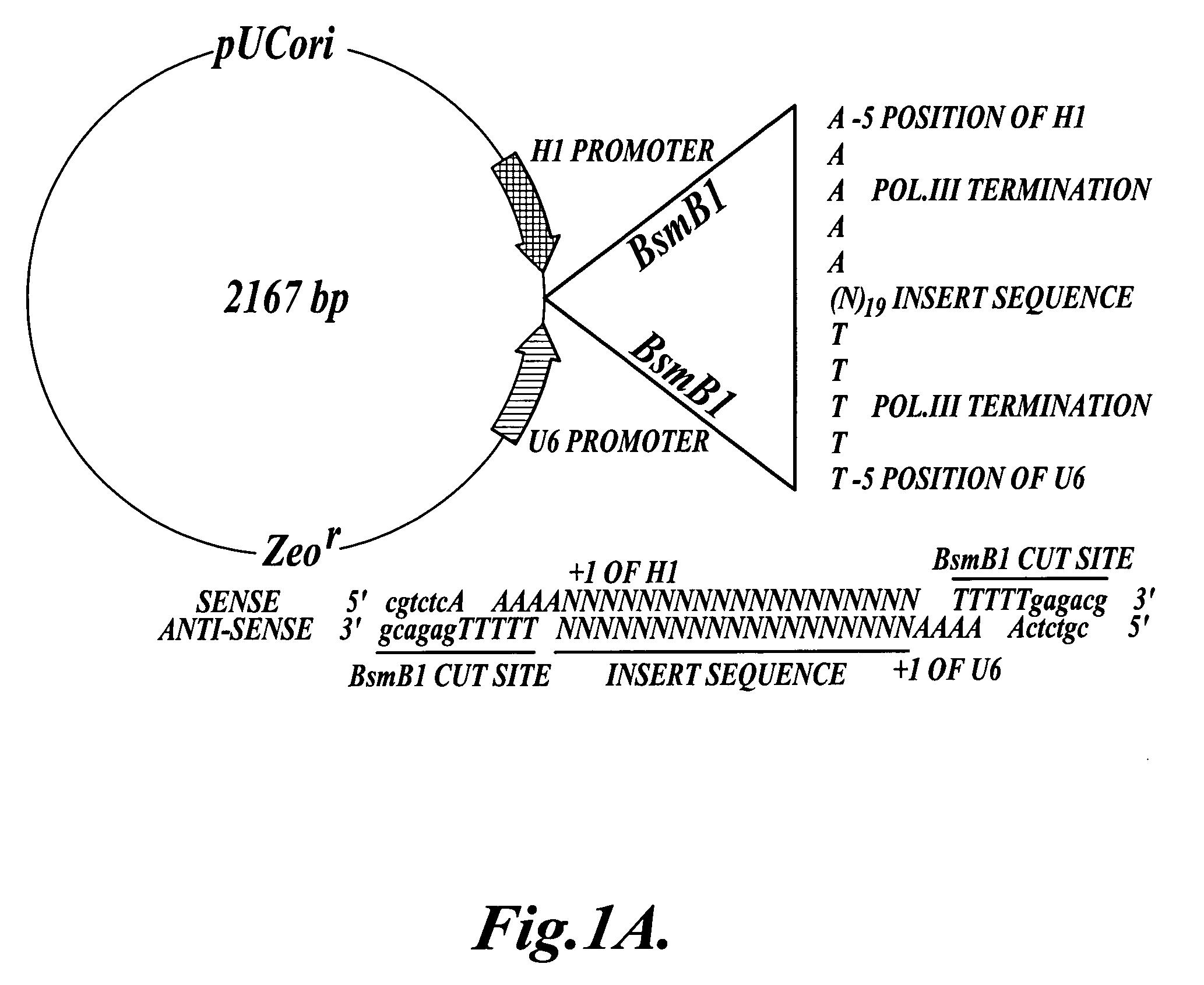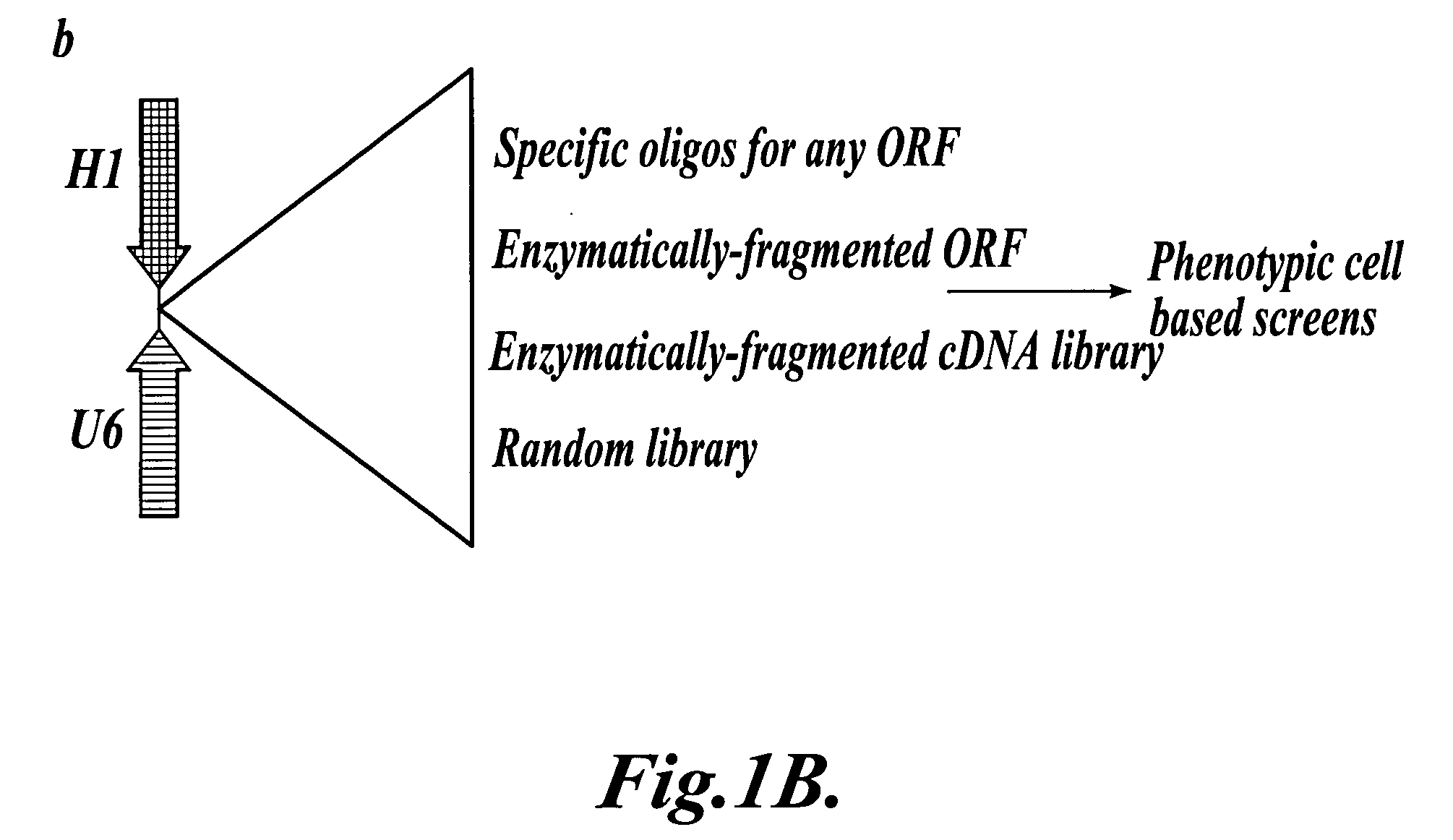Methods and vectors for expressing siRNA
a vector and sirna technology, applied in the field of methods and vectors for expressing small interfering rnas, can solve the problems of limited use of rnai as a tool to study gene function in mammalian, hairpin vectors suffer from multiple limitations, and hairpins are difficult to synthesiz
- Summary
- Abstract
- Description
- Claims
- Application Information
AI Technical Summary
Benefits of technology
Problems solved by technology
Method used
Image
Examples
example 1
[0093] This example describes the construction of siRNA expression vectors according to the invention by cloning and their use to specifically inhibit target gene expression.
[0094] Construction of phippy vector: The pHippy vector contains two opposing RNA polymerase III promoters to drive the expression of both strands of a template DNA cloned in between the promoters. To circumvent generating an inverted repeat, which can cause plasmid instability in E. coli, the human H1 and human U6 polymerase III promoters were used instead of two H1 or two U6 promoters. Both the H1 and U6 promoters were modified to contain a five thymidine polymerase III termination sequence at the −5 to −1 position, and a BsmB1 restriction enzyme recognition site at the −12 to −6 position, as shown in FIG. 1A. The sequence of the modified H1 promoter is provided in SEQ ID NO:2; the sequence of the modified U6 promoter is provided in SEQ ID NO:3. pHippy also contains a PUC origin of replication and the Zeocin-...
example 2
[0111] This example describes the construction of siRNA expression vectors according to the invention by PCR and their use to specifically inhibit target gene expression.
[0112] To generate pHippy siRNA constructs in a rapid manner, a PCR method was devised that incorporates the U6 and H1 promoters from pHippy on either end of a PCR product. A gene-specific primer for a target gene can be sandwiched between the two convergent promoters. To develop this system three oligonucleotides were synthesized:
[0113] (1) a 97 nucleotide primer consisting of the entire modified H1 promoter from pHippy, 5′ atttgcatgtcgctatgtgttctgggaaatcaccataaacgtgaaatgtctttggatttgggaatcttataagtggatcctgagaccgt ctcaaaaa 3′ (H1p97, SEQ ID NO:30);
[0114] (2) a target gene-specific primer containing 18 nucleotides of complimentary sequence to both the modified H1 and U6 promoters and 21 nucleotides of gene-specific (PGL3 luciferase) or random control sequences, 5′ ctgagaccgtctcaaaaa ggctcctcagaaacagctc tttttgagacgc...
example 3
[0119] This example describes the construction of siRNA expression vectors according to the invention for transcribing random libraries of siRNA molecules.
[0120] The pHippy system is well suited for generation of cDNA or random insert libraries because both strands of DNA template are transcribed to generate siRNA. To determine whether pHippy could in principle be used for a random screen, a random library of sequences based on PGL3 luciferase was generated. This library was generated by randomizing the final 3 nucleotides (CTC) in the sense strand of the PGL3-specific insert described in EXAMPLE 1 and corresponds to a library of 64 possible inserts.
[0121] To determine whether this library could be screened to recover siRNA activity, 130 randomly chosen clones from E. coli containing the library were picked and pooled in groups of 10. These 13 pools were screened for their ability to inhibit PGL3 luciferase activity, as described in EXAMPLE 1. The library consisted of a maximum of...
PUM
| Property | Measurement | Unit |
|---|---|---|
| size | aaaaa | aaaaa |
| cell surface molecule | aaaaa | aaaaa |
| length | aaaaa | aaaaa |
Abstract
Description
Claims
Application Information
 Login to View More
Login to View More - R&D
- Intellectual Property
- Life Sciences
- Materials
- Tech Scout
- Unparalleled Data Quality
- Higher Quality Content
- 60% Fewer Hallucinations
Browse by: Latest US Patents, China's latest patents, Technical Efficacy Thesaurus, Application Domain, Technology Topic, Popular Technical Reports.
© 2025 PatSnap. All rights reserved.Legal|Privacy policy|Modern Slavery Act Transparency Statement|Sitemap|About US| Contact US: help@patsnap.com


